Art Tatum Jazz Heritage Festival
Toledo OH, 18-19 June 2005
by David Dupont
18 July 2005
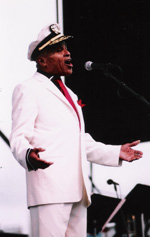 |
Jon Hendricks (©David Dupont) |
The Art Tatum Jazz Heritage Festival in Toledo, Ohio, has lofty dreams to match its impressive name. This year marked the sixth year the festival has been presented as a tribute to Tatum, a Toledo native. Staged in a park across the river from downtown, the festival is as much a celebration of the city as it is of music. From bearing the name of its most distinguished native son to its focus on local and regional acts, the Tatum Fest has strong roots in the industrial heartland. This has always been its strength. In the past even the internationally famous headliners have been there because of some local connection.
Not coincidentally, the festival took wing shortly after another local man done well, Jon Hendricks, returned to the city to teach at the University of Toledo. Since then he’s served as a presiding eminence, always on hand, even if he’s not performing, in his crisply-tailored candy-colored suits and matching captain’s hat to bless an event with his beaming smile and well-aged voice. Probably the highpoint of all the festivals to date was a couple years ago when Kurt Elling headlined and Jon Hendricks and his daughter Michelle joined him on stage for a stunning round of jazz vocal pyrotechnics.
The festival’s aspirations are fueled by generous corporate support led by a $100,000 grant from DaimlerChrysler; the German-owned car company manufactures its Jeep line in Toledo. And those dreams involve marquee names as headliners, the kind of stars that will draw an audience beyond the hardcore jazz cognoscenti. Last year, the first year DaimlerChrysler signed on in a big way, it was Nancy Wilson and Ramsey Lewis. This year, it was George Benson.
But at 2 p.m. on Saturday, volunteers—the no-name folks who actually get events like these up and running and packed away—were still hustling around tending to final details. The smell of barbecue wafts through the air as Po’ Mo’ Ribs gets busy, and on the stage a local big band from nearby Sylvania’s Northview High School is sounding the first notes of the festival. Spreading the jazz word to a new generation is an explicit subtext of the festival, though the three of the five headliners—Hendricks, Ellis Marsalis and Jimmy McGriff—represent the music’s elder generation. The band accounts for itself well with a credible sense of swing and capable solos.
The youngsters yielded the stage to a group of local veterans. The Murphys, the house band from Murphy’s Place, took the stand first as a trio with regulars Claude Black on piano and club owner Clifford Murphy on bass joined by drummer de jour Wendell Robinson. Black, who accompanied Aretha Franklin back when she still sang jazz and split when the singer took a turn to the pop and profitable side, embodies the sound of Motown jazz. His music is steeped in the blues, but informed by urban sophistication. He may stride along easily at first to establish the mood, but as his playing intensifies he’ll splay intricate bebop figures played in octaves that burst into cascading clusters. He’s a treasure.
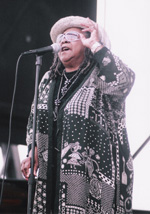 |
Odessa Harris (©David Dupont) |
Detroit singer Odessa Harris was inspired by her backup band. Her voice is imbued with the blues, yet she sings standards. The 69-year-old singer delivers the text with a casual directness as if she were talking to an old friend over coffee. Harris weighs each word, then tosses it away, letting it spiral off in the air. Her repertoire was musical comfort food—“Route 66”, “Every Day I Have the Blues”, “Days of Wine and Roses”, “I’ve Got You Under My Skin”, and the first of several festival versions of “Georgia on my Mind”. Recently back from a long layoff, she spoke to her joy to be back singing by altering Ira Gershwin’s line on her closer “‘Swonderful” to: “It’s wonderful that all you should care for me.”
As the set was being changed, musicians taking part in the African American Legacy Project’s oral history effort to document Toledo’s jazz scene were introduced. They included Murphy and Black, as well as Leon Cook and percussionist Tony Ben, who were scheduled to perform later in the day. It was a welcome reminder of just how deep the roots of the music go here. It also reflected on the concern among the jazz cognoscenti about what some see as a weakening bond between African-Americans, the community from which the music sprouted, and the music as it exists now. The Tatum Festival does draw strong support from local African-Americans, both as members of the audience and as volunteers. From the earliest arrivals until the crush for the headliners, the festival draws a diverse ethnic mix. It’s a beautiful scene.
Though the presentation served to whet the appetite to hear some of those honored play, instead an out-of-towner took the stage. Singer Jenna Mammina, now of San Francisco but with roots in Michigan, sings a mix of old-time jazz and New Age folk. She earned her billing on the stage with a recent show at a Toledo club that so impressed certain fans hereabouts that they suggested her return. A club would be a better setting for her. She sings with a hip, flirtatious twang. With stalwart support from guitarist Neal Alger, she sings with a smile in her voice, as if she were leaning over to tell the listener a secret. She opened with “Taking My Sugar to Tea”, and proceeded to mix in standards with originals and the Elvis Costello tune “Watching the Detectives”.
The sound seemed too intimate to carry through to a crowd that was still scattered over the grounds—regular festival goers have their favorite spots, the shelter of a large willow being especially preferred, and she met with only mixed success on getting the crowd engaged. She tried a sing-along and then with better results got members of the audience to suggest words—bacon, Northern lights, curmudgeon, smoke, among them—which she then worked into a song she created on the spot. By the end she won the crowd over with the force of her good nature.
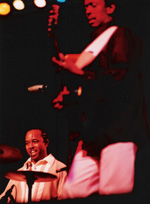 |
Damon & Leon Cook (©David Dupont) |
Guitarist and vocalist Leon Cook took the stage next. Cook’s a veteran local performer who knows how to mix straight-ahead fare with soulful pop jazz. He didn’t sing much at the festival, except for delivering the festival’s second version of “ Georgia on my Mind”. His band featured his son Damon on drums, Ben on percussion, and jazz everymen Gene Parker on piano and saxophone and Jeff Halsey on bass. This edition of Cookin’—the name Cook uses for his ensembles—had a more straight-ahead bent to it, opening with a long striding version of “Impressions” and including a fast clip take on “Seven Steps to Heaven” kicked along by young Damon Cook. The highlight of the set was a shimmering version of the 1970s pop hit “You Make Me Feel Brand New”, an inspired tune selection.
The Madison, Wisconsin band Phunk Phunktion was an obvious play to the young crowd. The band was booked at the behest of the 20-something grandson of the Toledo Jazz Society’s founder. The band is a jazz-tinged party band with a sound like an updated Steely Dan. The septet—usually a septet but their trombonist had to return to Wisconsin because of a family emergency—mixes vocals with tight horn voicings and percolating percussion over an insistent backbeat. I was sitting behind two five-year-old cousins who were up and dancing as the band launched into its more hip-hop influenced song. Still the band couldn’t quite shake the crowd from its overcast day doldrums.
The mood brightened a bit as hometown hero Hendricks arrived, as sartorially resplendent as usual. Hendricks has a husky, well-traveled voice. He opened his set with a series of tunes just backed by a trio, working through “Bright Moments”, a Basie blues, and “Tell Me the Truth”, which had some biting social commentary including the line, “Jesus is just another superstar for you to adore.” Afterward he offered some advice to the crowd: rattling off a list of clubs that feature live jazz in the city, he urged them to “support these places so our art form can thrive”.
Then he introduced his wife Judith and local singer Joel Hazard as “Lambert, Hendricks and Ross Redux”. With six horns now in tow, they roared through “Every Day I Have the Blues” with more enthusiasm than polish. Then, told that Frank Fountain, the DaimlerChrysler official who arranged the funding for the festival was there, Hendricks dedicated a song to him. The car company, it turned out, had a while back used one of Hendricks’ hits, “Yeah, Yeah”, for a commercial. The company probably didn’t know he wrote the song, Hendricks said, but he knew once the royalty checks started to arrive.
He continued with a couple more favorites: “Do You Call That a Buddy?”, in which he finally stirred the crowd to participate a little and Louis Jordan’s “Saturday Night Fish Fry”. Then he changed the mood to perform an arrangement of the Miles Davis-Gil Evans version of “Bess, Where’s My Bess?” The performance had a workshop quality to it, ragged along the edges, searching for its center. With the other singers back though, Hendricks closed with panache, running through “Little Pony”, “April in Paris”, and “Avenue C”.
Before headliner Ellis Marsalis could take the stage, Toledo Mayor Jack Ford, who is in a tough race for re-election, made an appearance to give Marsalis one of several crystal keys to the city he bestowed on visiting artists over the weekend. Ford, who touted his work with Fountain and DaimlerChrysler to get the grant, was on stage so much during the weekend, he almost could have served as a master of ceremonies. The mayor expressed hope that the festival could continue to grow. While such sentiments were greeted with loud applause I couldn’t help but be concerned. Would continuing the trend toward “big names” detract from the local character that makes the festival so special? This region, which includes Detroit, has a rich tradition of jazz and blues, and celebrating that heritage gives the Tatum festival its own distinctive niche.
Marsalis took the stage with a quartet featuring son Jason on drums with Derek Douget on saxophone and Bill Huntington on bass. After an afternoon devoted to music that explored the hedgerows between jazz and various forms of pop, the Marsalis quartet offered up a bracing set of quietly intense modernism. Marsalis’ elegance and sense of structure masks the adventure in his lines. He’s the kind of player who, if it weren’t for his famous progeny, would remain a well-respected player, little known outside New Orleans. Thanks to his sons’ coattails we all get to enjoy his work.
Though a decidedly cosmopolitan ensemble, the quartet retains a certain New Orleans flair. One of the standout performances of the evening was Jason Marsalis’ well-constructed drum spot on a blues by Big Easy clarinetist Alvin Batiste. On the band’s closing romp through “Sweet Georgia Brown”, Douget blew a soprano spot that evoked the sound of old New Orleans while consistently veering away from the expected.
The evening closed with more news from New Orleans in the body of Los Hombres Calientes, led by trumpeter Irvin Mayfield and percussionist Bill Summers. Opening with Ornette Coleman’s “Lonely Woman”, the septet charged through a set of music informed by the various strains of Caribbean music. Each song swept through shifting moods and grooves. Mayfield tempers the flash of his playing with a deeply felt lyricism. His tone is mellow no matter how heated his playing.
The band’s two other brassmen Leon Brown, trumpet, and Steve Walker, trombone, provided contrasting brilliance. Brown soared into the upper register, and Walker swooped and slid with giddy abandon through his spots, on a rampage that traversed the entire spectrum of indigenous sliphorn tradition from tailgate to freeform with a healthy seasoning of salsa. Co-leader Bill Summers also proved to be a master at integrating the vast Afro-Caribbean tradition in a way that’s informed by his own scholarship but maintains the communicative power of a village drummer. The set ended with “Down on the Bayou”, which evolved from chanting to a labyrinth of cross-rhythms. Like other acts during the Saturday show, Los Hombres endeavored to engage the audience in the music. The singsong line that Mayfield summoned from the crowd, which had thinned as the temperatures dropped, remained half-hearted.
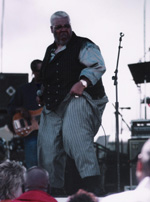 |
Rance Allen (©David Dupont) |
If the crowd’s response to performers seemed to reflect the overcast skies on Saturday, the arrival of local gospel Grammy-nominee Rance Allen to open the Sunday show proved the musical equivalent of that day’s brilliant blue skies. By a few bars of his first numbers, he had the crowd rocking harder that anything felt the night before. Allen preaches the gospel to a funk beat. He’s unapologetic about his religious message. “I want me some white people come down here and dance,” he said, adding that if it was a rhythm ‘n’ blues act they would be up front shaking their booty. Allen said he plays “r and b”—“rhythm and Bible”, but the beat is infectious. Allen danced across the stage with a light-footed grace that belied his hefty frame. He sings with an expressive freedom that evokes saxophonist David Murray, climbing the ladder from register to register. It was a riveting performance. Allen generated main event excitement.
I almost felt sorry for the next act up, a combo from the Toledo School for the Arts. The youngsters acquitted themselves well with set of jazz standards. Headliner George Benson, who was strolling around the grounds, later praised the band’s performance as a sign of the health of the music. The band, which featured multi-instrumentalist Andy Zuercher—he played vibes, drums, guitar and sang—also played at the kids’ tent. My 15-year-old daughter reported that at that venue they used a DJ as well mixing in hip-hop influences. While she allowed they were fine on the main stage, she found their kids tent mix far more exciting, and truth be told, probably the music she most enjoyed all day.
The main stage on Sunday, however, had a decidedly mainstream tone featuring two regional combos led by saxophonists. Steve Wood’s quartet opened with George Russell’s “Ezzthetic”, a daring opening to a probing set that leaned heavily on the Monk book. That modernist cast, with a couple more nods to Monk, also marked the work of the next group up, the University of Toledo’s faculty jazz ensemble led by saxophonist Gunnar Mossblad. The leader’s duet with drummer Wendell Robinson on his own “Ice Pick”, a variation on Monk’s “Skippy”, pushed the music further out than anything else heard over the two-day event. And the audience’s response showed that out-sounds can make an impact.
Both Wood and Mossblad returned to the stage as members of the Toledo Jazz Orchestra. The orchestra, which is sponsored by the Toledo Jazz Society, traditionally sets up the festival’s headliners. The band performs a series of theme concerts throughout the year, but relies on a more far ranging repertoire at the festival. The set included a couple of Tom Kubis charts band a version of Wayne Shorter’s “Fe-Fi-Fo-Fum”. The ensemble playing is unfailingly sharp, and the solos self-assured. The TJO serves as a showcase for many of the best local musicians, including veteran bebopper Jimmy Cook.
Hendricks joined the band to sing “Don’t Worry ‘Bout Me”, which the singer introduced as “one of the good old good ones”. Hendricks is a marvelous interpreter of the standard repertoire. I’d love to hear him do a set shorn of jive and special projects, just straight-ahead ballad singing. His voice has roughened a bit with age, but his interpretive powers have deepened. No male singer now active gets to the heart of a lyric the way he does. It stems for a love of the material.
A couple years ago I overheard him as he talked with friends after Mark Murphy’s festival performance. Something in the show had reminded him of a song, and he was expounding on the ballad’s virtues, softly yet surely singing to illustrate his point. That vignette has stuck in my mind—though I can’t remember exactly what the song was—as much as anything that’s happened under the lights at the festival. Hendricks loves company, so after his solo turn his wife and Hazard joined him to revisit “Jumpin’ at the Woodside”. With the band cooking behind them, it proved a rousing performance. The two little girls in braids were up and swinging along with the band.
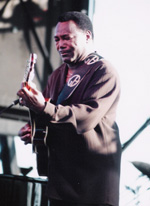 |
George Benson (©David Dupont) |
Still that traditional swing seemed an odd introduction for fusioneer George Benson. Not that the crowd, numbering at least 2,200 based on ticket sales, minded. The park was packed anticipating the star’s show. This was clearly Benson’s crowd, boomers, black and white, with Benson’s 1970s hits as fresh as yesterday in their internal jukeboxes.
Benson’s clearly aware of the nostalgic links his listeners have to the music. He fronts a band that delivers versions that are true to the tenor of the original hits while also leaving room for a smidgen of spontaneity. Benson even graciously stepped aside on “Music Makes Me Cry” to let rhythm guitarist Michael O’Neill rip a biting rock solo. He also brought percussionist and backup vocalist Kenya Hathaway up front to join him on a rendition of her father Donnie’s “Talkin’ About the Ghetto”.
While Benson came up as a soul jazz guitarist, he put the spotlight on his singing by opening the set with a ballad. Only after setting the mellow tone did he pick up his guitar for “Breezin’”. The set seemed to be transmitted from a time warp. It was full of familiar Benson numbers as well as another rendition of “ Georgia on My Mind” that had members of the crowd gesturing to friends and smiling broadly as they recognized the familiar strains. One woman wept during “Turn Your Love Around” and then pranced about playing air guitar during “Into the Night”.
At the risk of losing my credentials as a certified jazzhead, I should note the performance was effective, musically sound. Benson sings with a rich, romantic voice that doesn’t have much interpretive nuance, yet speaks to his fans. It was a love fest that had the audience on its feet and stomping at the end with a number of them folding their chairs and blankets and heading for the exit.
The festival has made a practice of having an act after the headliner, almost as a kind of denouement. Organist Jimmy McGriff batted clean up, though he didn’t start before the mayor showed up to bestow a final key to the city. Fronting a quartet of saxophonist David Wither and the father-son duo Leon and Damon Cook ( Leon has played and recorded with McGriff) the organist delivered a smoking set of blue-tinted grooves. The material had the intimacy of the last early morning set at a club. He kept things at a simmer. On “Muddy Water”, Wither stepped forward for a long testifying solo. The set proved a low-key, yet satisfying close to the festival that set in relief the big dreams so often expressed during the day.
|

